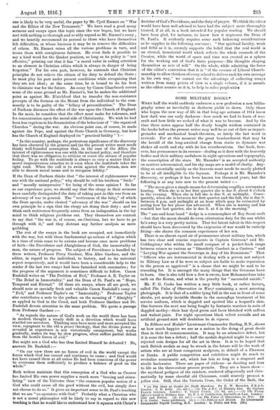SOME MILITARY BOOKS.*
WHEN half the world suddenly embraces a new profession a new biblio- graphy arises as inevitably as darkness yields to dawn. Only those who began the new way of life in that long-ago autumn of 1914 know how dark was our early darkness—how much we had to learn of war- craft and how little we reeked of what it was to become. And by the time these notes appear half the dearly bought wisdom contained in the books before the present writer may well be as out of date as impact. grenades and mechanical bomb-throwers, so lately the last word in revivals. For at this moment the great bombardment that may be the herald of the long-awaited change from static to dynamic war shakes all earth and sky with its low reverberations. One book, how- ever, has permanence in its essence—dealing as it does with the heavenly bodies and their military usefulness in night operations and topography, the conscription of the stars. Mr. Maunder is an accepted authority on matters astronomical, and his sky maps are a model of clarity. Any- thing so essentially untidy as the heavens must needs be neatly plotted to be at all intelligible to the layman. Perhaps it is Mr. Maunder's discovery, or perhaps it has been known ten thousand years, but the following is at any rate new to the present writer :— "The moon gives a simple means for determining roughly a sonensaLT
bearing. When she is in her first quarter she is clue S. about 6 o'clock in the evening. When she is full she is due S. at midnight. Conse- quently, when she is between her first quarter and the full, she is due S. between 6 p.m. and midnight at an hour which may be estimated by noting how far her phase has advanced. When she is waning and has reached her last quarter, she is due S. at 6 in the morning."
The " sun-and-hour-hand " dodge is a commonplace of Boy Scout craft —but that the moon should do even orientation duty for the sun whilst he's away is a very pretty notion. That her latent talent in this respect should have been discovered by the exigencies of war would be entirely fitting—she shares the common experiences of her sex.
There is an almost equal air of permanence about military law, which
has two clear and concise exponents in Captain Grierson2 and Mr. Coddington,s who within the small compass of a pocket-book range between crimes so various as "Disorderly Conduct in a Canteen" and " Levying War against the Sovereign in Any of his Dominions." That "Officers who are instrumental in dealing with a person not subject to Military Law as if he were so subject are liable to make reparation to the person so aggrieved" is a clause that we might be said to be crusading for. It is amongst the many things that the Germans have to learn. One is also told how a Jew is sworn, how Mohammedans take oath on the Koran, and what is the penalty for "successful suicide."
Mr. F. G. Cooke has written a racy little book, or rather lecture, called The Value of Observation in War,4 containing a most arresting photograph. It is that of a soldier lying full in the sun in front of some shrubs, yet nearly invisible thanks to the camouflage treatment of his service uniform, which is dappled and spotted like a leopard's skin. One foresees the next war being fought by fantastic warriors in suits of dappled motley—their hair dyed green and faces blotched with saffron and walnut-juice. For night operations black velvet overalls and an artificial ground-mist will doubtless be de rigueur.
In Ribbons and Medals' Lieutenant-Commander Dorling, R.N., shows us how much happier we are as a nation in the doing of great deeds than in their fit commemoration. It may be an attractive defect, but it is none the less a defect; half the medals depicted might be so many rejected coin designs for all the art in them. It is to be hoped that such British medals as may be struck in the future will be the work of artists who are at least competent sculptors, in default of a Flaxman or Banks. A public competition and exhibition might do much to revitalize numismatio art, which has lain so long in a stagnant and sterile backwater. There are pages of ribbons—as dazzling and true to life as the three-colour process permits. They are a brave show— the mythical pedigree of the rainbow, rendered allegorically and chro- matically by some cheerful old Chinaman, could scarcely present a jollier riot. Still, that the Victoria Cross, the Order of the Bath, the
• (1) The Stars as Guides for Night Marching. By E. W. Maunder, F.R.A.S. London : C. H. Kelly. [2s. net.]—(2) The 4.B.C. of Military Law. By Captain
Francis Grierson. London: T. Fisher Litwin. 178. 6d. net. 3) The Young Offices Guide to Military Law. By F. J. O. Coddinston, Barrishir-at-Law. London: Gale and Polden. 12s. Gd. net.)—(4) The Value of Observation in War. By F. G. Cooke. Same publishers. [la.]—(5) Ribbons and Medals. By Lieutenant-
Commander Taprell Moiling, R.N. London : Philip and Son. (28.1
French Legion of Honour, and the Army Long Service and Good Conduct medals, among others, should all have plain red or crimson ribbons of only slightly varying shades seems to point to a lack of imagination even in the design of ribbons. Perhaps the Official Decorating Department could be induced to call in a lady well versed in such mysteries to advise them in this weighty matter of ribbons. There should be no great difficulty in securing such expert and valuable advice—gratis. We arc all war workers now.



























 Previous page
Previous page